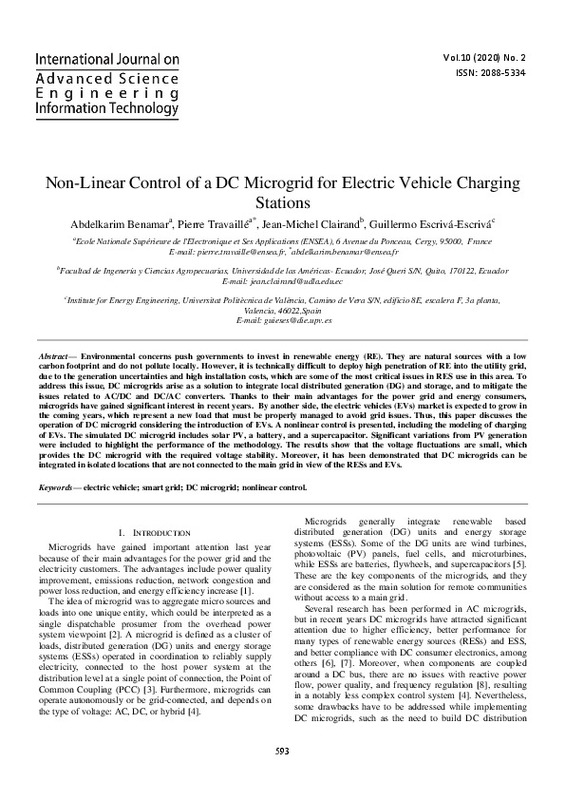JavaScript is disabled for your browser. Some features of this site may not work without it.
Buscar en RiuNet
Listar
Mi cuenta
Estadísticas
Ayuda RiuNet
Admin. UPV
Non-Linear Control of a DC Microgrid for Electric Vehicle Charging Stations
Mostrar el registro sencillo del ítem
Ficheros en el ítem
| dc.contributor.author | Benamar, Abdelkarim
|
es_ES |
| dc.contributor.author | Travaillé, Pierre
|
es_ES |
| dc.contributor.author | Clairand Gómez, Jean-Michel
|
es_ES |
| dc.contributor.author | Escrivá-Escrivá, Guillermo
|
es_ES |
| dc.date.accessioned | 2021-07-14T03:31:14Z | |
| dc.date.available | 2021-07-14T03:31:14Z | |
| dc.date.issued | 2020 | es_ES |
| dc.identifier.issn | 2088-5334 | es_ES |
| dc.identifier.uri | http://hdl.handle.net/10251/169179 | |
| dc.description.abstract | [EN] Environmental concerns push governments to invest in renewable energy (RE). They are natural sources with a low carbon footprint and do not pollute locally. However, it is technically difficult to deploy high penetration of RE into the utility grid, due to the generation uncertainties and high installation costs, which are some of the most critical issues in RES use in this area. To address this issue, DC microgrids arise as a solution to integrate local distributed generation (DG) and storage, and to mitigate the issues related to AC/DC and DC/AC converters. Thanks to their main advantages for the power grid and energy consumers, microgrids have gained significant interest in recent years. By another side, the electric vehicles (EVs) market is expected to grow in the coming years, which represent a new load that must be properly managed to avoid grid issues. Thus, this paper discusses the operation of DC microgrid considering the introduction of EVs. A nonlinear control is presented, including the modeling of charging of EVs. The simulated DC microgrid includes solar PV, a battery, and a supercapacitor. Significant variations from PV generation were included to highlight the performance of the methodology. The results show that the voltage fluctuations are small, which provides the DC microgrid with the required voltage stability. Moreover, it has been demonstrated that DC microgrids can be integrated in isolated locations that are not connected to the main grid in view of the RESs and EVs. | es_ES |
| dc.description.sponsorship | This work belongs to the project SIS.JCG.19.03 from Universidad de las Américas - Ecuador | es_ES |
| dc.language | Inglés | es_ES |
| dc.publisher | Indonesian Society for Knowledge and Human Development | es_ES |
| dc.relation.ispartof | International Journal on Advanced Science, Engineering and Information Technology | es_ES |
| dc.rights | Reconocimiento - No comercial - Compartir igual (by-nc-sa) | es_ES |
| dc.subject | Electric vehicle | es_ES |
| dc.subject | Smart grid | es_ES |
| dc.subject | DC microgrid | es_ES |
| dc.subject | Nonlinear control | es_ES |
| dc.subject.classification | INGENIERIA ELECTRICA | es_ES |
| dc.title | Non-Linear Control of a DC Microgrid for Electric Vehicle Charging Stations | es_ES |
| dc.type | Artículo | es_ES |
| dc.identifier.doi | 10.18517/ijaseit.10.2.10815 | es_ES |
| dc.relation.projectID | info:eu-repo/grantAgreement/UDLA//SIS.JCG.19.03/ | es_ES |
| dc.rights.accessRights | Abierto | es_ES |
| dc.contributor.affiliation | Universitat Politècnica de València. Departamento de Ingeniería Eléctrica - Departament d'Enginyeria Elèctrica | es_ES |
| dc.description.bibliographicCitation | Benamar, A.; Travaillé, P.; Clairand Gómez, J.; Escrivá-Escrivá, G. (2020). Non-Linear Control of a DC Microgrid for Electric Vehicle Charging Stations. International Journal on Advanced Science, Engineering and Information Technology. 10(2):593-598. https://doi.org/10.18517/ijaseit.10.2.10815 | es_ES |
| dc.description.accrualMethod | S | es_ES |
| dc.relation.publisherversion | https://doi.org/10.18517/ijaseit.10.2.10815 | es_ES |
| dc.description.upvformatpinicio | 593 | es_ES |
| dc.description.upvformatpfin | 598 | es_ES |
| dc.type.version | info:eu-repo/semantics/publishedVersion | es_ES |
| dc.description.volume | 10 | es_ES |
| dc.description.issue | 2 | es_ES |
| dc.relation.pasarela | S\431223 | es_ES |
| dc.contributor.funder | Universidad de las Américas, Ecuador | es_ES |
| dc.subject.ods | 07.- Asegurar el acceso a energías asequibles, fiables, sostenibles y modernas para todos | es_ES |








